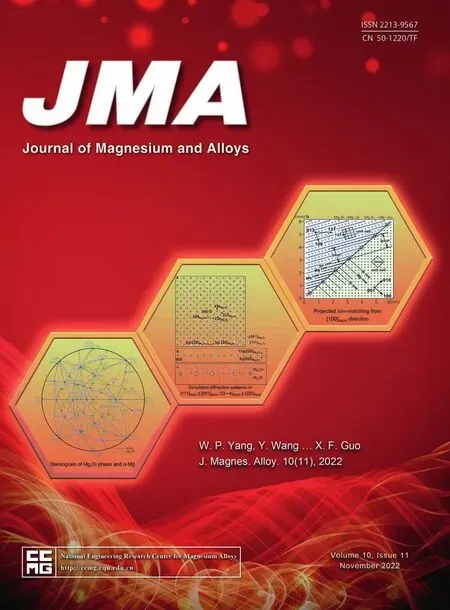The microstructure evolution and deformation mechanism in a casting AM80 magnesium alloy under ultra-high strain rate loading
2022-12-30PengchengGuoXioLiuBiwuZhuWenhuiLiuLiqingZhng
Pengcheng Guo,Xio Liu,Biwu Zhu,Wenhui Liu,Liqing Zhng
a School of Mechanical and Electrical Engineering,Central South University of Forestry and Technology,Changsha 410004,China
b School of Material Science and Engineering,Hunan University of Science and Technology,Xiangtan,Hunan 411201,China
Abstract Ultra-high strain rate impact tests were conducted by Split-Hopkinson pressure bar to investigate the microstructure evolution and impact deformation mechanism of a solution treated casting AM80 Mg alloy at 25,150 and 250 °C with a strain rate of 5000 s−1.The microcrack and dynamic recrystallization (DRX) preferentially nucleate at grain boundary (GB) and twin boundary (TB),especially at the intersections between GBs and TBs,and then propagate along twin direction.In contrast,the adiabatic shear bands preferentially occur at high-density twined regions.At 25 °C,the dominated deformation mechanisms are basal slip and twinning.As deformation temperature increases to 150 and 250 °C,the deformation gradually shifts to be dominated by a coordinated mechanism among non-basal slip,twinning and DRX.The fl w stress behavior and deformation mechanism indicate that the degree of decrease in fl w stress with temperature is associated with the change of deformation mode.
Keywords: AM80 mg alloy;Deformation mechanism;Ultra-high strain rate;Twinning;Dynamic recrystallization.
1.Introduction
As an important lightweight structural material,Magnesium (Mg) alloy is widely used in the field of automobile,weapon and aerospace [1].In addition to bearing quasi-static loads,structures made by Mg alloy inevitably withstand dynamic loads such as high-speed impact at various temperatures.It is well known that deformation under high-speed impact load is a complex and highly nonlinear process [2],resulting in different behaviors as compared with that under quasi-static load.Generally,the strain rate (SR) under highspeed impact load can reach 103–104s−1,and the mechanical response vary with deformation temperature and loading SR[3–6].
Under quasi-static load,twinning is one of the main deformation mechanisms in Mg alloys [7].When subjected to high-speed impact load,in addition to twinning,dislocation slips on prismatic and second order pyramidal planes are also activated for compatible deformation[5].As reported,{102}tensile twinning is sensitive to applied SRs [8–10],and the contributions of twining and dislocation slip are visibly different as compared with those under quasi-static load [11].Under high-speed impact load,the fl w stress of AZ31 Mg alloy still exhibits strain hardening even at 300°C[12].Additionally,a large number of twins are detected,and no dynamic recovery occurs,indicating that dislocation slip and twinning are the main deformation mechanisms [12].The strain hardening rate (SHR) shows a transition from twin to dislocation controlled plasticity [13].With further increase in temperature,the deformation mechanism gradually converts to dislocation slip,thereby twinning hardly occurs and deformation homogeneity increases [12].When the deformation temperature is lower than 400 °C,the deformation of Mg-Gd-Y Mg alloy is dominated by basal slip,then changes to be dominated by non-basal slip as temperature further increases,at which the fracture mode converts to intergranular fracture [14].

Fig.1.Split-Hopkinson pressure bar apparatus.
There have been numerous studies that indicate that the deformation mechanism in Mg alloys is strongly affected by deformation temperature and applied SR [7–20].However,the high-speed impact deformation mechanism in Mg alloys at various temperatures is unclear.In present study,the microstructure evolution and deformation mechanism under ultra-high SR load are investigated with a solution treated casting AM80 Mg alloy.
2.Experimental procedure
The raw materials for smelting of AM80 Mg alloy were magnesium,aluminum and electrolytic manganese,and their purity (wt.%) were 99.98%,99.6% and 95.1%,respectively.A mixture of tetrafluoroet ylene(CH2FCF3)and carbon dioxide (CO2) was used as protective gas.During smelting,solvent manganese was used for flam retardant.After refining the molten metal was casted into a metal mold(Φ90 mm × 500 mm) at 720 °C.The preheating temperature of the metal mold was 250 °C.The cast ingots with chemical composition of Mg-8.0Al-0.1Mn (wt.%) were solution treated at 450°C for 16 h followed by air cooling to room temperature.Specimens used for high-speed impact tests were machined from the solution treated ingot into small cylinders with height of 4 mm and diameter of 8 mm.The relative position is consistent with that in Ref.[7].High-speed impact experiments were conducted at 25,150,and 250 °C using a Split-Hopkinson pressure bar (SHPB) apparatus with loading SR of 5000 s−1.The SHPB apparatus is shown in Fig.1,which consists of a striker bar,an incident bar,a transmission bar and an absorber bar at the end (Fig.2).Before tests,all the specimens were heated up to the predefine temperature and soaked with 5 min to ensure the temperature uniformity.After tests,the deformed samples were water-quenched immediately.The stress-strain data at the same deformation condition is the average of 3 valid experiments.Ultra-highstrength steel rings with an inner diameter of 12 mm,an outer diameter of 20 mm and heights of 3.6,3.4,3.2 and 2.8 mm were used as limiting blocks to obtain the specifie strains of 0.10,0.15,0.20 and 0.30.
Samples for microstructure observation were cut through the center of cylinders along or parallel to the impact direction.The observation positions for optical microscopy (OM),electron backscatter diffraction(EBSD)and transmission electron microscopy (TEM) are shown in Fig.3.Sample preparation for OM observation consisted grinding with 600,1200 and 2000 grit SiC papers,mechanical polishing with 3.0 and 1.0 μm alcohol-based diamond suspensions and fina etching with an acetic-picral solution [7].Twin and dynamic recrystallization (DRX) were characterized using an EBSD technique in a Zeiss Supra 55 FEG scanning electron microscope working at 20 kV.The EBSD data was analyzed using (hkl)Channel 5 data acquisition and analysis software.Samples for EBSD were mechanical ground with 4000 grit SiC paper,polished with 0.05 μm silica suspension and fina electrochemical polished for 90 s at 33 V using the AC2TMcommercial electrolyte.TEM samples were thinned to perforation with a precision ion polishing system,and then observed by a TecnaiG220 TEM with operating voltage of 200 kV.The initial OM images of the studied AM80 Mg alloy in as-cast and solution treated states are shown in Fig.4.The average grain size of the solution treated alloy is estimated to be ∼136 μm with the aid of linear intercept method.
3.Results
3.1.Dynamic stress response behavior
The true stress-true strain curves of the studied alloy impacted at SR of 5000 s−1are shown in Fig.5.The fl w stress decreases rapidly as deformation temperature increases from 25 to 150 °C,and the decrease amplitude reduces apparently when deformation temperature increases to 250 °C.At 25 °C,the fl w stress shows a slight reduction with increasing strain as it increases to peak value.As reported,this is mainly attributed to that the strain hardening is completely offset by the softening effect induced by sharp increase of local adiabatic temperature rise in later deformation stage[21,22].In contrast,the fl w stress monotonously increases with the increase of strain during the whole deformation process when impacted at 150 and 250 °C,exhibiting continuous strain hardening.Furthermore,the fl w stress under ultra-high SR load is visibly higher than that under quasi-static load [7].

Fig.2.Schematic of Split-Hopkinson pressure bar apparatus.

Fig.3.Schematic of observation positions for OM,EBSD and TEM.
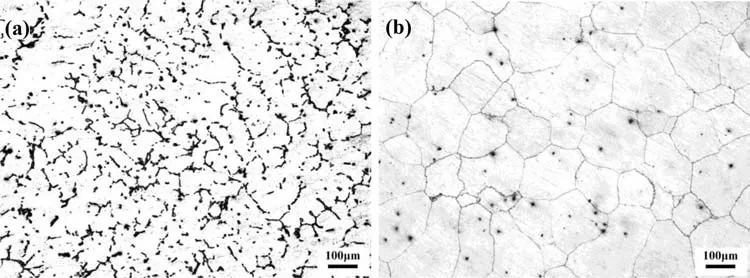
Fig.4.Initial OM images of the studied alloy: (a) as-cast state,(b) solution treated state.

Fig.5.True stress-true strain curves of the studied alloy at various deformation temperatures.
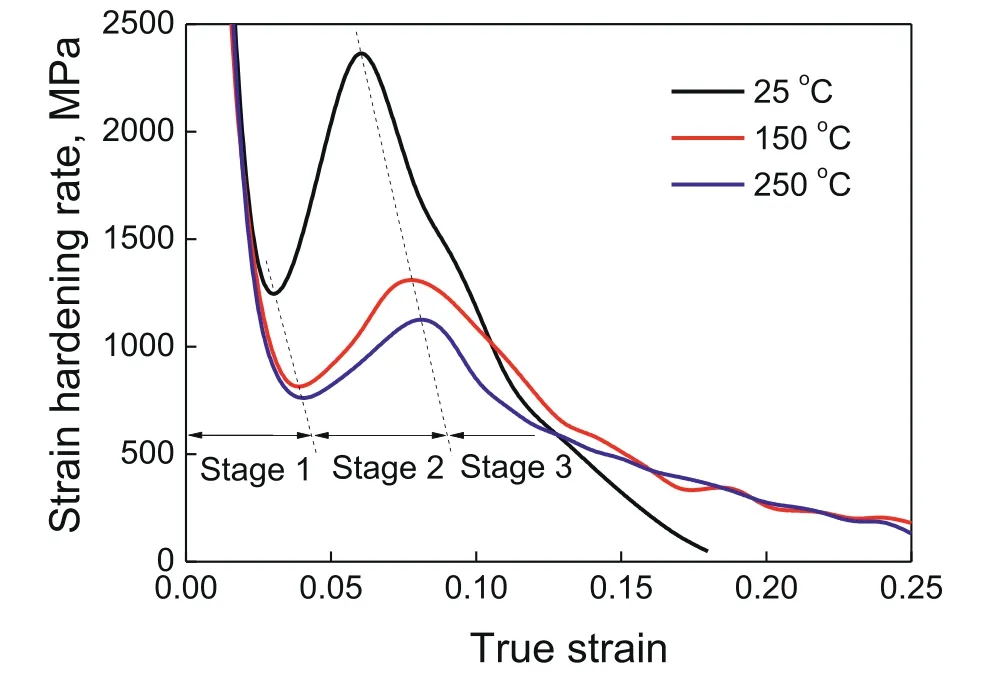
Fig.6.SHR as a function of applied true strain at various deformation temperatures.
The relationship between SHR (dσ/dε) and true strain (ε)at the SR of 5000 s−1is shown in Fig.6.Clearly,the SHR decrease visibly as deformation temperature increases.These curves can be roughly divided into three stages.In the firs stage,the SHR decreases sharply with the increase of applied strain.This is mainly attributed to the rapid increase of dislocations at the beginning of plastic deformation,which reduces the driving force required for further slip of dislocations.Therefore,the stress is temporarily relaxed.In the second stage,the SHR turns into increase with increasing strain.In the third stage,the SHR translates into decrease with the increase of applied strain,and the decreased rate declines significantl as compared with that in the firs stage.
As shown in Fig.6,the dynamic strain hardening behavior of the studied AM80 Mg alloy in the second and third stages are strongly dependent on deformation temperature.With the increase of deformation temperature,the initial and terminal strains of the second stage increase approximately linearly,while the corresponding slopes decrease sharply.It is reported that,with the increase of temperature,the deformation mechanism in this stage gradually changes from twin dominated to twin-slip dominated [2,13],which is supported by the decline of SHR with increasing deformation temperature.In addition,the sustained strains of the second stage at various deformation temperatures are basically the same (ε≈0.05).In the third stage,the SHR at 150 and 250°C gradually evolve to be essentially the same.In contrast,the fall of SHR at 25 °C is much sharper.This can be attributed to delay in twin induced texture change [23,24] and high local adiabatic temperature rise [7,19],leading to texture softening,adiabatic temperature rise softening and large local adiabatic shear deformation.As a result,the SHR in middle and late of the third stage is lower than that at high deformation temperatures (150 and 250 °C).It is well known that non-basal slip in Mg alloys can induce forest of dislocations and increase the dislocation density effectively [24].These dislocations are continuously absorbed by the boundaries of dislocation cells and transformed into sub-boundaries,which finall induces DRX [20,24,25].This is helpful to understand the behavior that,at 150 and 250 °C,the SHR begins to decrease as the impacted strain increases to∼0.08.The subsequent OM results indicate that the decrease in SHR at the strain of ∼0.08 is induced by DRX.
3.2.Microstructure evolution
Figs.7–10 show the typical deformed OM results of the studied alloy impacted at 25,150 and 250 °C with SR of 5000 s–1.The compressive strains of (a–d) in each figur are 0.10,0.15,0.20 and 0.30,respectively.At all deformation temperatures,a lot of twins are detected in middle deformation stage (ε= 0.10 and 0.15).Additionally,twin bands which intersect with each other are observed in some grains,as marked with red arrows in Figs.7–10.However,there are significan differences in microstructure evolution at different deformation temperatures.
When impacted at 25°C,the twin density increases and the twin spacing decreases with increasing strain.At the strain of 0.10,a lot of parallel twins with average spacing of ∼21 μm are detected in most of grains.These twins nucleate at one side of grain boundaries (GBs) and then grow across their host grains.As shown in Fig.7,lots of twins completely penetrate their host grains.As the impacted strain increases to 0.15,the twin density increases apparently.Note that most of the detected twins are parallel to each other and only a small number of intersected twins occur,which are similar to the results at the strain of 0.10.In addition,some twins have been bent or twisted as marked with yellow arrows in Fig.7b.These twins are called distorted twins.When the impacted strain increases to 0.20,the change in twin density is small,while the number of secondary twins and distorted twins increase visibly.As the strain further increases to 0.30,the twin density increases significantl ,and some microcracks marked with white arrows in Fig.7d are detected.These microcracks preferentially nucleate at GBs or twin boundaries(TBs),and then propagate along TBs until they penetrate the entire grains,causing some secondary twins which intersect with primary twins to be distorted(Fig.8).Additionally,some adiabatic shear bands(ASBs)initiating at high-density twined regions are detected,as marked with blue arrows in Fig.7d.It is noted that the adiabatic shear deformation is a gradually developing process and the propagation paths of the observed shear bands are curved.As shown in Fig.8b,the evolution of shear bands is a competitive process,the shear band 1 merges with the shear band 2 and then propagates along the direction of the wider shear band 2.In addition,the width of the shear bands varies along shear direction,and likewise,it also varies from one shear band to another.The measured width of the shear bands are within 7 μm.
When impacted at 150°C,the most apparent feature of the evolved microstructure is the occurrence of dynamic recrystallization (DRX).The DRX grains in Fig.9d are fin and equiaxed with average size of ∼3 μm.As shown in Fig.9,the twin density firs increases with increasing strain,and then decreases as the applied strain increases to 0.20 because some twins have been replaced by fin DRX grains.In contrast,the DRX fraction increases monotonously with the increase of applied strain.At the strain of 0.10,a lot of twins are detected and most of the primary twins cease far from the GBs on the other side,which are basically the same as those at 25 °C (Fig.7a).As the applied strain increases to 0.15,the twin density increases,while most of them are still primary twins,only a few secondary twins are detected,as shown in Fig.9b.In addition,some twins show a certain degree of distortion,which is similar to that at 25 °C.Note that lots of DRX grains are detected at GBs and TBs when the applied strain increases to 0.20.As shown in Fig.9c,all the parallel twins and their adjacent regions have been transformed into fin DRX grains.Visibly,the DRX preferentially nucleates at GBs and TBs,especially at the intersections between GBs and TBs,and then propagates along twin direction until the entire twin has been transformed into DRX grains,at which the DRX expands to the regions between two parallel twins.As the applied strain increases to 0.30,complete DRX occurs in some regions,as shown in Fig.9d.Clearly,the grain size on the original GBs and TBs,especially on the intersections of TB to GB and TB to TB,are apparently smaller than those in other regions.Although a fully DRX occurs in these regions,the original GBs are still visible as the solute atoms have not diffused uniformly.
The microstructure evolution at 250 °C is similar to that at 150 °C,except that the strain required for DRX is apparently smaller.At the strain of 0.10,a low twin density and a small amount of fin DRX grains with average size of ∼3 μm are detected.As the applied strain increases to 0.15,most of twins and the regions between two parallel twins with a small spacing have been transformed into fin DRX grains,as shown in Fig.10b.The average fraction of DRX in the observed region (Fig.3) is about 43%,which is much higher than that at 150 °C (∼8%).As the applied strain increases to 0.20,complete DRX occurs in some regions (Fig.10c)with average grain size of ∼4 μm.Visibly,the grains grow slightly as compared with those at 150 °C.As the applied strain further increases to 0.30,the DRX grains grow further with different levels.As shown in Fig.10d,the grains in the center of host grains grow obviously with a maximum size of ∼19 μm,while the grains on the host GBs only show a slight growth.
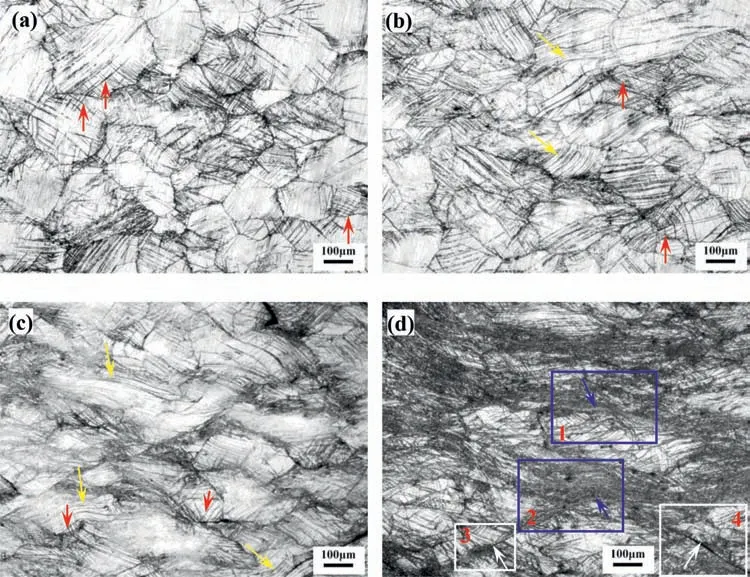
Fig.7.Typical OM images of the studied alloy impacted at 25 °C with SR of 5000 s−1: (a) ε = 0.10;(b) ε = 0.15;(c) ε = 0.20;(d) ε = 0.30 (For interpretation of the references to color in this figure the reader is referred to the web version of this article).
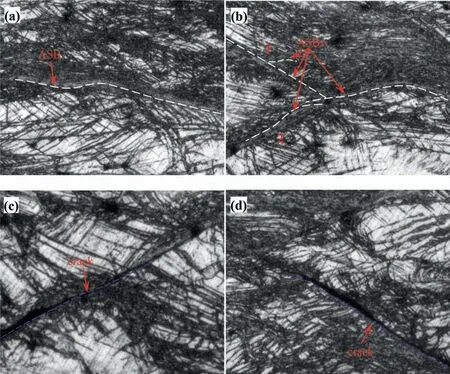
Fig.8.Enlarged images of the regions in Fig.7d: (a) region 1;(b) region 2;(c) region 3;(d) region 4 (For interpretation of the references to color in this figure the reader is referred to the web version of this article).
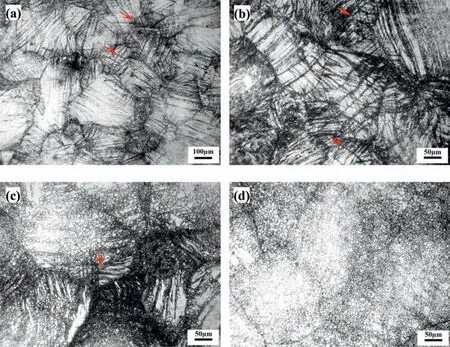
Fig.9.Typical OM images of the studied alloy impacted at 150 °C with SR of 5000 s−1: (a) ε = 0.10;(b) ε = 0.15;(c) ε = 0.20;(d) ε = 0.30 (For interpretation of the references to color in this figure the reader is referred to the web version of this article).

Fig.10.Typical OM images of the studied alloy impacted at 250 °C with SR of 5000 s−1: (a) ε = 0.10;(b) ε = 0.15;(c) ε = 0.20;(d) ε = 0.30 (For interpretation of the references to color in this figure the reader is referred to the web version of this article).
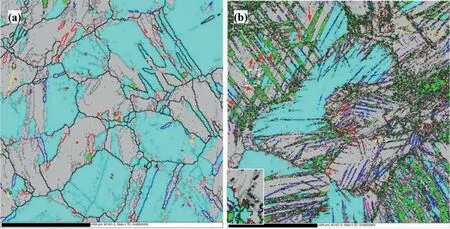
Fig.11.OIM maps of the studied alloy impacted under ultra-high SR load (ε = 0.15,SR = 5000 s−1): (a) 25 °C and (b) 250 °C (For interpretation of the references to color in this figure the reader is referred to the web version of this article).
Orientation imaging microscopy (OIM) maps with impacted strain of 0.15 are shown in Fig.11.Boundaries with anglesθ >12°and 2°<θ <12°are represented with black lines and gray lines.Similarly,86 ° {102}<110>extension twin boundaries,64 ° {103}<110>contraction twin boundaries,56 ° {101}<110>contraction twin boundaries and 38.6 ° {101}-{102}<110>double twin boundaries are colored in red,yellow,pink and blue,respectively.In addition,the regions with full recrystallization,substructure and deformation are colored in green,aqua and silver,respectively.As shown in Fig.11,a visibly lower fraction of substructure and a significantl higher fraction of DRX are detected at 250 °C as compared with those at 25 °C.In addition,three types of twins are detected in both deformation temperatures after ultra-high SR impact,while the number of them are visible different.
At 25 °C,extensive dislocations accumulate at TBs and GBs,resulting in significan grain subdivision.As reported,this is critical to enable DRX [26,27].In addition,high densities of {102}<110>tension twins and {101}-{102}<110>double twins are observed,while there are a few contraction twins.The {102}<110>tension twins and{101}-{102}<110>double twins induce thec-axes to rotate by 86°and 38.6°,respectively.The detected extension twin boundaries are not straight,as is commonly observed,which is consistent with the results in Ref.[17].As deformation temperature increases to 250 °C,the dislocation density apparently decreases because large numbers of dislocations have been consumed by DRX.Additionally,the DRX grains are detected in twined regions and distribute in stripe along twin direction,indicating that the DRX in the studied alloy under ultra-high SR impact occurs preferentially in twinned regions,especially the intersection of twins.Under high strain rate loads,the influenc of temperature on DRX mechanism is not obvious,while the deformation twin plays a significan role in DRX [5,28–30].These investigations have concluded that the twinning-induced DRX is the dominant DRX mechanism at high strain rate loads.Therefore,the DRX prefers to occur within twins in the regions with high density of twins.The transition of dominated DRX mechanism may occur as the twins are occupied by DRX grains [5].Furthermore,numerous small-angle GBs,which represent high dislocation density,are detected in twinned regions where only partial DRX has occurred,as shown in the magnifie image at the bottom left corner of Fig.11b.
Typical TEM images with impacted strain of 0.15 are shown in Figs.12–14,the observation regions of twin diffraction pattern are labeled with red circle.To easily identify the twin types,all the diffraction patterns are viewed along the same<110>direction of the matrix,which is consistent with that in the Ref.[31].Clearly,the deformed microstructures at 25 and 250 °C are significantl different,which are basically consistent with the OM results in Figs.7 and 10.
High-density dislocations and twins are detected when impacted at 25 °C.As shown in Fig.12,the high-density dislocations have evolved into cell-like structures,which can help to understand the slight decrease of fl w stress in later deformation stage (Fig.5).Diffraction patterns taken from the twined regions are show in Fig.13b and 13d,which are consistent with the patterns shown in Fig.1a and 1c of the Ref.[31].The c-axes of the twin and the matrix are rotated by 86°around the <110>direction,which indicates that the observed twin in Fig.13a is{102}twin.As shown in Fig.13d,the twin and the matrix are related by 37 ° rotation around the <110>direction.According to the analysis in previous investigations [31–34],the observed twin in Fig.13c can only be explained by double twinning of the {101}–{102}type.It should be specially noted that no traces of the primary {101} twinning is found in present study due to its extremely unstable characteristics [32].This is consistent with the results in TEM studies of the double twins in AZ31 Mg alloy [31,32].
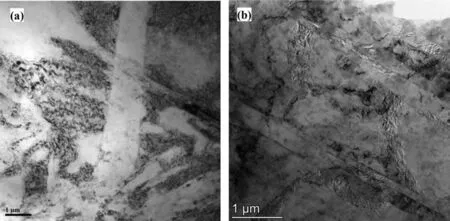
Fig.12.Cell-like dislocations in the studied alloy impacted at SR of 5000 s−1 and temperature of 25 °C with a strain of 0.15 (For interpretation of the references to color in this figure the reader is referred to the web version of this article).

Fig.13.Twins with their corresponding diffraction patterns of the studied alloy impacted at SR of 5000 s−1 and temperature of 25 °C with a strain of 0.15(For interpretation of the references to color in this figure the reader is referred to the web version of this article).
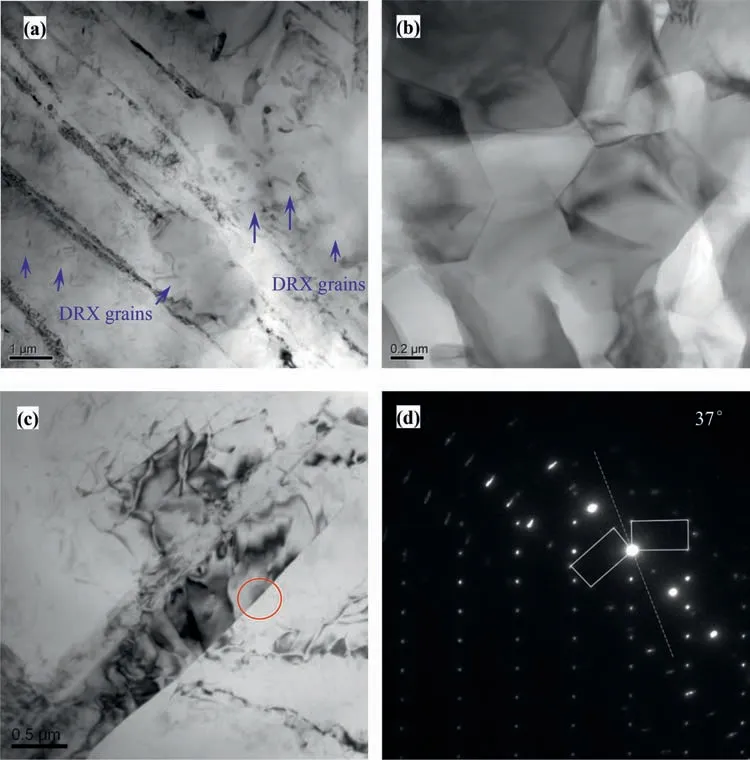
Fig.14.Typical TEM images of the studied alloy impacted at SR of 5000 s−1 and temperature of 250 °C with a strain of 0.15: (a) and (b) dislocations and DRX grains,(c) and (d) twin with its diffraction pattern (For interpretation of the references to color in this figure the reader is referred to the web version of this article).
As deformation temperature increases to 250 °C,the dislocation density is greatly reduced and replaced by a large number of ultra-fin DRX grains.In addition,twin is also detected,and the corresponding diffraction pattern is shown in Fig 14d.These are consistent with the results in Figs.10 and 11.As shown in Fig.14(a) and (b),the dislocation density in recrystallized regions is visibly low,and even no dislocation is detected in some DRX grains.Similar to Fig.13d,thecaxes of the twin and the matrix are rotated by 37 ° around the<110>direction,which indicates that the twin is a double twin of primary {101} and secondary {102} with different planes of shear [31].
4.Discussion
For Mg alloys,basal and prismatic slips offer only deformation in 〈a〉 direction,which does not satisfy the requirement of 5 independent slip systems for compatible deformation.〈c+a〉 type dislocation slip on second order pyramidal planes {111} can provide deformation inc-axis direction,while it is hard to activate at room temperature due to its high critical resolved stress(CRSS)[35,36].With the increase of deformation temperature,the CRSS required for activation of non-basal slip decreases sharply [37,38].As deformation temperature is higher than 280 °C,the CRSS ratio of nonbasal slip to basal slip reduces to 5–16,at which non-basal slip is easy to activate,finall increasing the deformation uniformity.When deformation temperature increases to 400 °C,the CRSS for prismatic and pyramidal slips reduce approximately equal to that for basal slip [39].In contrast,twinning is a non-thermal activation process and the critical twinning stress is insensitive to deformation temperature[29,39].In addition,the crystal orientation in the studied alloy is random.Thereby,tensile twinning occurs in a portion of grains with a large Schmid factor when the c-axis of crystal is stretched,and compressive twinning usually occurs in late deformation stage due to its high CRSS when the c-axis is under compressive stress [40].

Fig.15.The evolution of ASBs in the studied alloy under ultra-high SR load.
When impacted under ultra-high SR at 25 °C,the plastic deformation of the studied alloy in early deformation stage is primarily carried out in the form of basal slip,resulting in a low twin density,as shown in Fig.7a.With the increase of applied strain,the deformation gradually shifts to be dominated by a coordinated mechanism between basal slip and twinning.The larger the grain size,the more severe the accumulation of dislocations at GBs and the easier the twinning,thereby the twin density increases rapidly as shown in Fig.7b.The continuous increase of twins can effectively coordinate the orientation of grains,reducing deformation resistance and promoting dislocation slip.As shown in Fig.7d,the twins in the same band are basically arranged in parallel,roughly dividing their host grains into many small parts,the effect of which is similar to that of grain refinement Twinning is continuously consumed for compatible deformation by changing grain orientation.As a result,it becomes more and more difficul to continue twinning,and the adiabatic temperature rise caused by local plastic deformation visibly increases.As reported,the adiabatic temperature rise at room temperature during late deformation stage increases sharply when impacted under ultra-high SR load [7].As a result,the CRSS for non-basal slip greatly decreases,effectively promoting the activation of non-basal slip to harmonize plastic deformation.In contrast,the critical twinning stress slightly reduces because the nucleation of twinning is a non-thermal activation process.Therefore,the plastic deformation mechanism of the studied alloy at 25°C has shifted to be dominated by non-basal slip,accompanied with twinning for compatible deformation.
When deformation temperature increases to 150 °C,large number of non-basal slips will be activated due to sharp decrease of their CRSS.The plastic deformation in early stage also mainly occurs in the form of basal slip.With the increase of applied strain,a small amount of non-basal slips have been activated,which suppresses twinning,leading to a visibly lower twin density as compared with that at 25 °C(Figs.7 and 9).With the further increase of applied strain,the deformation gradually shifts to be dominated by a coordinated mechanism among basal slip,non-basal slip and twinning.The high densities of dislocations and twins make dislocations entangled with each other and gradually evolved into cell-like structures.Moreover,the host grains are refine by the intersection of twins,which are the precursor of sub-grains and then evolve into equiaxed DRX grains by rotation [41].The contribution of DRX under high temperature and ultrahigh SR load increases with the increase of applied strain,enhancing thermal softening and weakening strain hardening.Therefore,the fl w stress at 150 °C is much lower than that at 25 °C.The deformation mechanism of the studied alloy at 250 °C is basically the same as that at 150 °C,while its softening effect is more significan which further weakens the hindrance of GBs and TBs to dislocation slip.In addition,non-basal slip is fully activated with the further decrease of its CRSS,promoting DRX and resulting in an increase in the contribution of non-basal slip and DRX to plastic deformation.These help to understand the higher DRX fraction and the lower critical strain for DRX when impacted at 250 °C(Figs.9 and 10).Based on the above analysis,it can be concluded that the deformation of the studied alloy under high temperature and ultra-high SR load is dominated by a coordinated mechanism between slips (basal and non-basal slips)and DRX.
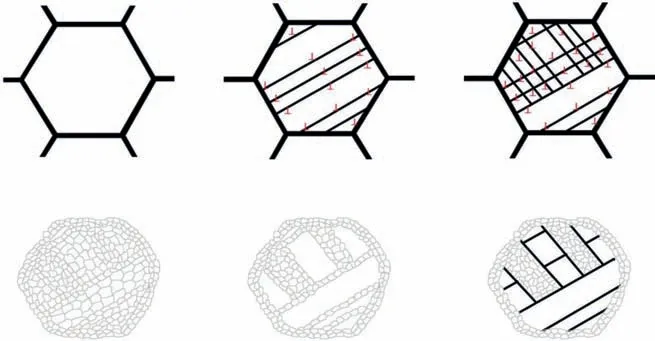
Fig.16.The evolution of DRX in the studied alloy under high temperature and ultra-high SR load.
At 25 °C,twinning is one of the main deformation mechanisms,which results in high density of twins and numerous twin intersections.The TBs,which serve as effective obstacles to dislocation motion,can induce significan dislocation accumulation [30].As reported,these are critical to enable ASB [9,18].Similarly,extensive dislocations accumulate at GBs,also resulting in significan grain subdivision [29,42].Therefore,the ASBs are detected in high density twined regions (Fig.7),which is consistent with the results in Refs.[9,18].Furthermore,with the increase of applied strain,the deformation mechanisms in Mg alloys under high-speed impact load gradually change and the adiabatic temperature rise increases sharply [7].As a result,the shear deformation is gradually localized and the instantaneous deformation heat is too late to transfer and release,thereby the shear deformation occurs under nearly adiabatic condition [7,9].In late deformation stage,large deformation and sharp increase of temperature occur in extremely narrow local region,which induces the nucleation of ASBs.These tiny ASBs propagate in twinning direction and then connect with adjacent ASBs,evolving into strips of white bright ASBs finall.Therefore,it can be concluded that the adiabatic shear failure is a process of nucleation of ASBs followed by propagation,connection and link up.The detailed evolution of ASBs under ultra-high SR load is schematically shown in Fig.15.
As previously mentioned,the twinning and DRX are the dominated mechanisms in middle and late deformation stages when impacted at 150 and 250 °C,resulting in severe dislocation accumulation around TBs and GBs.These can effectively increase stress concentration and promote DRX finall.In addition,the solubility of solute atoms on GBs is relatively high,which can provide more particles for heterogeneous nucleation and suppress grain growth.Therefore,the DRX preferentially nucleates at GBs and TBs,especially at the intersections between GBs and TBs,and then propagates along twin direction until the entire twin has been transformed into DRX grains,at which the DRX expands to the regions between two parallel twins (Figs.9–11).This kind of DRX behavior is mainly attributed to the high strain energy in these regions,which is conductive to the nucleation of DRX.Moreover,the relatively high concentration of solute atoms in these regions reduces the driving force required for DRX nucleation.Due to the high nucleation rate,the grains at GBs and TBs,especially at the intersections of TB to GB and TB to TB,are apparently smaller than those in other regions(Figs.9 and 10).The detailed evolution of DRX under high temperature and ultrahigh SR load is schematically shown in Fig.16.Furthermore,the detected small-angle GBs at 250 °C (Fig.11b) indicate that large number of dislocations have been consumed by DRX.Based on the above analysis,it can be concluded that the twins and dislocations are consumed constantly by DRX with the increase of applied strain in middle and late deformation stages.This can help to understanding the significan reduction in fl w stress when impacted under ultra-high SR load with deformation temperatures of 150 and 250 °C.
5.Conclusions
The present study investigated the microstructure evolution and impact deformation mechanism of a solution treated casting AM80 Mg alloy under ultra-high SR load.The following conclusions are drawn:
(1) High densities of dislocations and twins,microcracks and ASBs are detected when impacted at 25 °C.As deformation temperature increases to 150–250 °C,the densities of twins and dislocation reduce visibly,and a lots of fin and equiaxed DRX grains are detected.
(2) The microcrack and DRX preferentially nucleate at GB and TB,especially at the intersections between GBs and TBs,and then propagate along twin direction.In contrast,the ASBs preferentially occur at high-density twined regions.
(3) Basal slip and twinning are the dominated deformation mechanism when impacted at 25 °C.As deformation temperature increases to 150–250 °C,the deformation gradually shifts to be dominated by a coordinated mechanism among non-basal slip,twinning and DRX.The contributions of DRX and non-basal slip to plastic deformation increase with the increase of deformation temperature.
Declaration of Competing Interest
1.All author of this manuscript have directly participated in planning,execution,and/or analysis of this study,and there is no conflic of interest.
2.The contents of this manuscript have not been copyrighted or published previously.
3.The contents of this manuscript are not now under consideration for publication elsewhere.
4.The contents of this manuscript will not be copyrighted,submitted,or published elsewhere while acceptance by Journal of Magnesium and Alloys.
Acknowledgments
This work was supported by the National Natural Science Foundation of China (Nos.51975201 and 52071139)and the Natural Science Foundation of Hunan Province (No.2019JJ50586).
杂志排行
Journal of Magnesium and Alloys的其它文章
- Effect of crystallization on purity of volatile metallic magnesium prepared from a one-step multi-region condensation process under vacuum condition
- Tribological behaviour of AZ31 magnesium alloy reinforced by bimodal size B4C after precipitation hardening
- Thermodynamic assessment of Mg−Ni−Y system focusing on long-period stacking ordered phases in the Mg-rich corner
- Primary Mg2Si phase and Mg2Si/α-Mg interface modifie by Sn and Sb elements in a Mg-5Sn-2Si-1.5Al-1Zn-0.8Sb alloy
- Quasi-in vivo corrosion behavior of AZ31B Mg alloy with hybrid MWCNTs-PEO/PCL based coatings
- Evaluation of corrosion resistance,mechanical integrity loss and biocompatibility of PCL/HA/TiO2 hybrid coated biodegradable ZM21 Mg alloy
